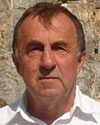2009
|
[ view response ] |
[ view response ] |
Citation by Susan H. Cannon and William H. Schulz
It is with great pleasure that we present the 2009 E.B. Burwell, Jr. Award to Matthias Jakob and Oldrich Hungr for their book Debris-flow Hazards and Related Phenomena.
Landslides are among the most deadly and damaging of geological processes, and most losses from landslides are from debris flows and the related phenomena, hyperconcentrated flows and lahars. These phenomena can be dangerous because of their great mobility, high impact forces, and large inundation areas, as well as the difficulties associated with predicting their location, size, and time of occurrence. Recognition of hazards posed by debris flows increases with each deadly event, and thus study of debris flows has flourished in recent decades. However, results from important work have remained scattered throughout various journal publications, conference proceedings, and consulting reports. Fortunately for all of us in the field, Drs. Jakob and Hungr recognized the necessity for a concise presentation of the state-of-the-science knowledge of debris-flow hazards and expended considerable effort to compile, partly write, and edit such a volume. The result is Debris-flow Hazards and Related Phenomena.
As experts in debris-flow science, Drs. Jakob and Hungr were keenly aware of the varied subject matter most vital for understanding and mitigating debris-flow hazards. They identified the leaders from the global community of scientists and engineers who study debris flows and solicited from them wonderfully written chapters that describe the most up-to-date knowledge of the phenomena. Drs. Jakob and Hungr themselves made outstanding contributions to the book, including a thorough introduction to debris-flow hazards, an explanation of the relations between various classification systems and terminologies that are used worldwide, and discussions of two critically important topics, enlargement of debris flows by entrainment and analysis of hazards posed by debris-flow movement. The resulting book is a well-rounded compendium on the subject including analytical and empirical modeling of debris-flow and related processes, description of tools for their study, and case histories, all of which focus on practical, predictive tools that may directly reduce debris-flow hazards.
The outstanding value of the book is evident not only in the authorship of the 27 chapters, but in the subject matter that is covered and the organization by which it is presented. The book begins with an overview of the debris-flow problem, a synthesis of terminology and definitions used worldwide, and a presentation of the historical significance of debris flows and their understanding. These introductory chapters provide the reader with a strong foundation for what is to come and are aptly followed by chapters describing the most advanced knowledge on slope failures that may result in debris flows, mechanisms resulting in debris-flow mobility, and debris-flow growth by entrainment. As the reader has then developed an understanding of debris-flow initiation and movement, the book presents chapters describing the related phenomena of hyperconcentrated flow, subaqueous debris flows, and volcanic debris flows (lahars). The following chapters describe tools for identifying and studying debris-flow-prone areas and debris-flow processes and related conditions. To provide understanding of factors contributing to debris-flows, the next chapters discuss how external forcing, such as climatic change, wildfire, and timber harvesting control temporal and spatial patterns of debris-flow occurrence. The wealth of knowledge just presented culminates in chapters on debris-flow hazard analysis and mitigation. The volume concludes with nine exceptional case histories describing well-understood debris-flow events, hazard assessments, and mitigation activities from around the world.
As we hope is evident from the description above, the book Debris-flow Hazards and Related Phenomena presents a unique and outstanding synthesis of the state-of-the-science knowledge of some of the most damaging and deadly of geological phenomena. We believe, as the editors had hoped, that the book will help reduce the loss of lives and property from future debris flows and related phenomena. For these reasons, the book is a very worthy recipient of the 2009 E.B. Burwell, Jr. Award.
 2009 E.B. Burwell, Jr. Award — Response by Matthias Jakob
2009 E.B. Burwell, Jr. Award — Response by Matthias Jakob
It is with great pleasure that we learned about this award. Clearly, these types of books are not compiled for commercial benefit nor for personal glory. A science Harry Potter is yet to be written. Rather they evolve out of the feeling of necessity to extract advances in a science for the benefit of those scientists and practitioners who do not have the opportunity to sift through hundreds of articles on the subject published in a variety of journals and conference proceedings. Most importantly, they give us the chance to condense a subject to a common scientific denominator on which we can orient our own academic efforts and consulting practice. While the publication of a book ought to be enough satisfaction to warrant the countless hours that have gone into it, receiving an award in recognition of the effort is a deeply gratifying experience that we would like to extend to all the authors who have made this publication possible, and who have put up with our nagging, friendly and unfriendly reminders over the course of two years. Thanks are also due to the publishers, especially to Philip Blondel and Clive Horwood who have kept this book on course.
We thank our nominators for their citation and the award committee for their choice that will certainly motivate us to continue our publication record and maybe, one day, provide an update to this book!
 2009 E.B. Burwell, Jr. Award — Response by Oldrich Hungr
2009 E.B. Burwell, Jr. Award — Response by Oldrich Hungr
I am very grateful to the GSA and to the nominators, Drs. Cannon and Schulz for this prestigious award that relates to the book “Debris-flow Hazards and Related Phenomena”. It is encouraging to see one’s daily work recognized by colleagues. However, I cannot claim this honour as my own. A large part of it, of course, belongs to Dr. Matthias Jakob who, with his characteristic unbounded energy, enthusiasm and skill, was the driving engine for the project. An even larger part of the recognition is due to the 44 chapter authors who represent leading experts on debris flows from five continents.
Once again, thank you, all.


